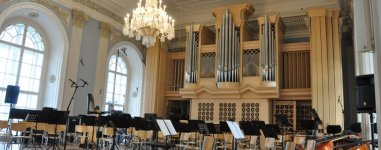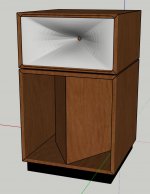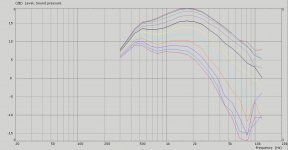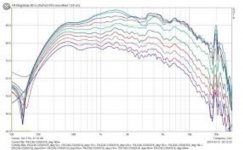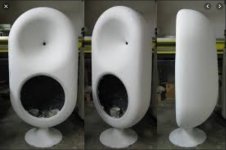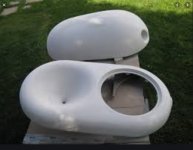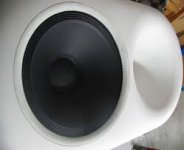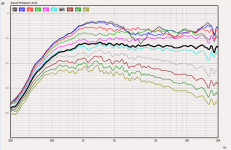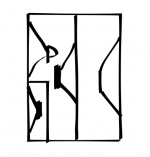This is a story from 2014. The speakers were built by a guy who is an aircraft engineer, very skillfull and equipped, he made it all himself at home. I remember that this big and heavy enclosure was extremely rigid and acoustically dead - some sandwich construction. The driver was 1" P.Audio PA-D45 (quite a monster) - maybe I could find the measured data. We measured these together at HAMU in Prague, musical academy right under the Prague Castle, they have an anechoic chamber there. Unfortunatelly these were never finished as the man has since a more important work to do - airplanes I guess. Pity I have lost much of the photos...Very nice! Any more info?
The photo above is from his yard measuring the speakers on an equipment he built one afternoon just for this purpose.
Attachments
To me compression drivers are all pretty much the same. It is the waveguide and crossover that makes for 90% of the sound quality.
Same experience. Now question is which factory in China makes good copies and is open to modify existing models.
When dealing with China you need to be very cautious. That's why I stayed with the Italians - very reliable - no games.
Thanks Ro808!
The evidences that you have proposed to me are very clear, however the 15p80FeN seems to have an almost double efficiency compared to the 15PR400, I don't know exactly what this involves in the sound, I suppose a more speed and greater damping for which I would be oriented towards the Beyma .... what do you think about it ...
Thanks, greetings to all.
Mleod
For 'speed' you'd buy a 911 Carrera S 😉
The 15P80FeN is very nice woofer, BUT it's best used in horn cabs.
If you want to build a big 2 way, there are plenty of very good alternatives available from Beyma.
Last edited:
Why Beyma. There are lots of good woofers out there. The major factor in a great loudspeaker is system design, not the drivers. Almost any drivers will work if the system design is right. People obsessing over drivers is a misplaced notion. They buy the current fashionable drivers and then ruin the system design through compromises and wonder why everything went wrong. Then they get to do it all over again.
My system design has changed little in almost 20 years and I still use that same design. I've updated the crossover several times and changed drivers, both of which made small but appreciable differences, but the major factor has always been the system design. Get that right and you are 85% of the way there. Compromise on the system and no driver is going to correct it.
My system design has changed little in almost 20 years and I still use that same design. I've updated the crossover several times and changed drivers, both of which made small but appreciable differences, but the major factor has always been the system design. Get that right and you are 85% of the way there. Compromise on the system and no driver is going to correct it.
Last edited:
When dealing with China you need to be very cautious. That's why I stayed with the Italians - very reliable - no games.
I don't like deal with China, discussion is always meaningless. Quickest would be demagnetize locally at STX and modify myself.
The question is "What would you change?" is it really worth it if the driver is a commodity?
Back in 2007 I evaluated a DE250 knockoff that was about $15. It was a good copy, but I would have to buy 100 of them.
Back in 2007 I evaluated a DE250 knockoff that was about $15. It was a good copy, but I would have to buy 100 of them.
For example I need 3-4" VC neo comp driver with motor allowing put large plastic insert with different exit apertures, Verstis phase plug, diaphragm classic titanium with aquaplas coating or ty out others like self reinforced PP, magnesium with coating etc, soft suspension.
Mitch, your 2384s are still very good imo.
In the complete system the M2 wg is undoubtely a competent performer, but this only after a considerable amount of processing.
The wg+D2 and the woofer are not an ideal match.
It's no wonder the wg doesn't load the driver very well below 1000Hz, if you look at its depth, or lack thereof.
Thanks Ro808.
But as can be seen from some of the recent polar's, there is better.
Given most large 2-ways are 15" woofer(s), one would have thought a 15" or 18" optimised matching constant directivity waveguide would be readily available for 1.4 or 1.5" exit CD's (which seem to be the best comprise for crossing low and still making it out to the top octave)...
PS. Love the latest set of measurements - very nice waveguides - cool LaScala!
From the web archive I could find only some poor resolution thumbs...This is a story from 2014...
But you can see that even a waveguide this big (OSWG about 20") in an enclosure this smooth is not free of axial issues when not terminated good enough (this was before I gained the knowledge of how to do that). It's not just the size.
BTW, one more thing I remember was that the driver used (P.Audio PA-D45) was very clean sounding during the (very loud) sweeps for the measurements. Much more than DE500 that we measured right before in a similar speaker. Does it really mean something? I don't know, it's just that everybody noticed. The target crossover point was around 700 Hz IIRC.
Attachments
Last edited:
For example I need 3-4" VC neo comp driver with motor allowing put large plastic insert with different exit apertures, Verstis phase plug, diaphragm classic titanium with aquaplas coating or ty out others like self reinforced PP, magnesium with coating etc, soft suspension.
3-4" neo compression drivers must be available (I am not up on the market, especially not Pro, who are the only ones who would need that large a diaphragm.) The unique part is interchangeable phase plugs. No one is likely to do that, especially since I patented it many years ago. The patent ran out, but that still means that no protection could be obtained.
As to the diaphragm material, I never saw this as a big factor - mostly fashion.
Certainly if your are doing sound reinforcement at super high levels the diaphragm material is critical, but nobody here has been talking about that. It's virtually always home Hi-Fi DIY, and drivers for that application are readily available.
Given most large 2-ways are 15" woofer(s), one would have thought a 15" or 18" optimised matching constant directivity waveguide would be readily available for 1.4 or 1.5" exit CD's (which seem to be the best comprise for crossing low and still making it out to the top octave)...
My experience was that the larger exit apertures did not get out to the last octave very well. The 1" seemed to be ideal in that some could go low (for home use) while still getting out to 13-15 kHz. The NS-15 crosses at about 800 Hz, but just gets to this last octave. I don't think a larger aperture could do that, and for just a few hundred Hz lower, it is not a compromise that I would make.
I have molds for waveguides just like you ask for (1" drivers), but one-offs are a significant amount of work and what I would have to charge would certainly turn you off.
Why always ported? That just seems like a old philosophy to me. Multiple subs negates any need for ports and their compromised low end performance (uncontrolled cone motion below port tuning.) Best just use closed boxes and Sub EQ.
The sharp roll-off is killing the tonal equilibrium of the sound reproduction, but the sound “bump” is always preferred, even by sound engineers. Have you studied this persistent sound preference (psychoacoustic) ?
Hi Ro808
I apologize for the inappropriate word ... a 911 Carrera S would suit me, too bad my finances won't let me ... lol, but I think you understood the concept.
I will remember your post, although I believe that at least one trial with 15p80 will be worth it. I want to clarify that they will be driven by a final of only 20 W and therefore it becomes mandatory to choose the most efficient woofer logically. In any case, thanks for the valuable advice and greetings.
Mleod
I apologize for the inappropriate word ... a 911 Carrera S would suit me, too bad my finances won't let me ... lol, but I think you understood the concept.
I will remember your post, although I believe that at least one trial with 15p80 will be worth it. I want to clarify that they will be driven by a final of only 20 W and therefore it becomes mandatory to choose the most efficient woofer logically. In any case, thanks for the valuable advice and greetings.
Mleod
I understand completely what Earl Geddes is saying and I agree with that. But he just assumes multiple subs as given. Well, for me and for a lot of people I know it is simply not, for various reasons. Again, I agree completely that is sub-optimal solution. So be it.The sharp roll-off is killing the tonal equilibrium of the sound reproduction, but the sound “bump” is always preferred, even by sound engineers. Have you studied this persistent sound preference (psychoacoustic) ?
This is the schematics of my latest construction - still in progress. With a passive crossover, three-way (15" + 12" + 1.4"driver) with a 4th order band-pass on the bottom end (presumably with a passive radiator). I expect a lot of performance from that - performace AND simplicity. All closed boxes.
Attachments
Last edited:
I do assume that one will use multiple subs. Otherwise all we are talking about is "almost as good." - Not very interesting.
The sharp roll-off is killing the tonal equilibrium of the sound reproduction, but the sound “bump” is always preferred, even by sound engineers. Have you studied this persistent sound preference (psychoacoustic) ?
Not really, but here is my take.
There should be no long ringing at LFs as this will sound boomy. The mix of the subs must insure that nothing rings. The room should be well damped (at LFs only!!) usually only effective if the walls are panel absorbers - otherwise too little effect. Tube traps are too little, too late. Then DSP to work yielding a smooth, flat (a few dB rise seems to work best,) uniform LF sound field. This, to me, yields the best bass - the bass that's in the mix, not in the room. Closed boxes are usually better damped than ported, which helps, I think.
It's really FAST!!!
Why Beyma. There are lots of good woofers out there. The major factor in a great loudspeaker is system design, not the drivers. Almost any drivers will work if the system design is right. People obsessing over drivers is a misplaced notion. They buy the current fashionable drivers and then ruin the system design through compromises and wonder why everything went wrong. Then they get to do it all over again.
My system design has changed little in almost 20 years and I still use that same design. I've updated the crossover several times and changed drivers, both of which made small but appreciable differences, but the major factor has always been the system design. Get that right and you are 85% of the way there. Compromise on the system and no driver is going to correct it.
Agreed on the system design and the abundance of good woofers available from numerous manufacturers.
Most of us are familiar with your scientific approach to loudspeaker system design, it's a source of information.
Particular driver characteristics and the implications have been discussed previously. It's probably not very useful to reopen this debate.
- Home
- Loudspeakers
- Multi-Way
- Is it possible to cover the whole spectrum, high SPL, low distortion with a 2-way?

